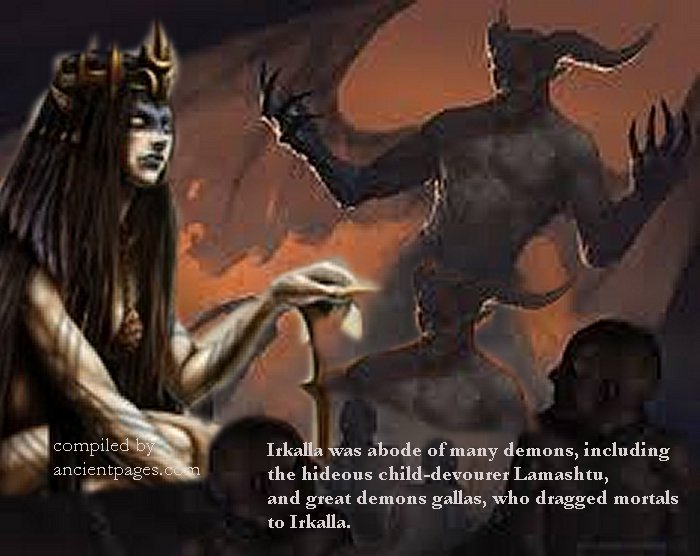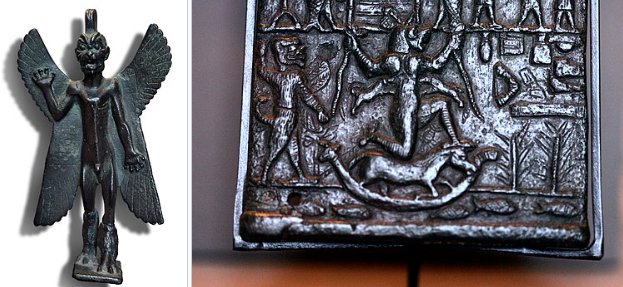Irkalla – Underworld With No Return Ruled By Ereshkigal, Granddaughter Of Enlil And Sister Of Inanna
A. Sutherland - AncientPages.com - In Babylonian mythology, Irkalla was the underworld from which there was no return. The realm of the dead or the lower world was also called Arali, Kur, Kigal, and Gizal.
There were two traditions explaining how humans entered the netherworld. According to one, the road to the underworld passed through the steppe land swarming with demons, across the Khabur River, and then through seven heavily guarded gates.
Another version described a road to the netherworld crossed by boat down one of the rivers of the upper earth. Then, across the apsu (the sweet waters under the earth) to Irkalla, the lower earth.
At first, the only ruler of Irkalla was Ereshkigal ("Queen of the Great Below"), a granddaughter of Enlil and older sister of Inanna (Ishtar). Later she ruled the netherworld with her husband, Nergal, the king of death who brings disease, plague, and all misfortunes caused by heat. Ereshkigal's judgment and laws were always indisputable.
Irkalla was the abode of many demons, including the hideous child-devourer Lamashtu, the fearsome wind demon and protector god Pazuzu, and great demons Gallas (or Gallu) busy with dragging mortals to Irkalla.
Location Of Irkalla
Based on various texts, it can be assumed that the Babylonians located the entrance to the underground world, where the sunset was in the western desert.
Left: Bronze statuette of Pazuzu (c. 800 – c. 700 BC). Credit: Public Domain - Right: Close-up of Lamashtu from a lead protection plaque dating to the Neo-Assyrian Period (911 – 609 BC). Credit: Public Domain
The Babylonian sun god, Shamash, descended to these regions in the evening. Then, he appeared again from the mountains in the east in the morning. The netherworld was situated even lower than the Abzu, the fresh-water ocean beneath the earth.
Grave Of The Deceased – The Entrance To Irkalla
In Babylonian writings, the grave was the entrance to the underground world for the man who was buried in it. The Sumerian beliefs inspired the Babylonian myths, which were later repeated and further developed.
All people, regardless of their positions, age or morals, descended after death to Irkalla. It was the same afterlife for all souls.
The only food or drink was dry dust, but family members of the deceased would pour libations for them to drink.
In "The Ark Before Noah: Decoding the Story of the Flood," Irving Finkel cites a description of Irkalla as a dreary place: The netherworld was described as a dreary place:
To the gloomy house, seat of the netherworld,
To the house which none leaves who enters,
To the road whose journey has no return,
To the house whose entrants are bereft of light,
Where dust is their sustenance and clay their food.
They see no light but dwell in darkness,
They are clothed like birds in wings for garments,
And dust has gathered on the door and bolt..."
(The Descent of Ishtar to the Netherworld" 4-11)
Not all views of the afterlife were the same among ancient beliefs of other cultures.
Unlike other views of the afterlife, in the Sumerian underworld, there was no final judgment of the deceased. The dead were neither punished nor rewarded for their deeds in life. Their burial conditions determined a person's quality of existence in the underworld.
Ancient Sumerian cylinder seal impression showing the god Dumuzid being tortured in the underworld by galla demons. Credit: Public Domain
As the dark underground realm, cut off from life and God, Irkalla was the ultimate destination for all who died. The domain is similar to Sheol (She'ol) of the Hebrew Bible, where all the dead - righteous and the unrighteous – must meet. It happens regardless of the moral choices and deeds made in life.
But at the same time, it is very different from more hopeful visions of the afterlife that later appeared in Platonic philosophy, Judaism, and Christianity, unlike visions of the ancient Egyptian afterlife.
After crossing the Hubur river, the deceased (naked or clothed in feathers like birds) stood in front of the seven city walls and had to pass through seven gates guarded by the guards. The ruler would pronounce them dead, and their names would be recorded on a tablet by a scribe.
In Irkalla, the deceased had to face Ereshkigal as they were born – naked, without garments and personal ornaments.
Written by – A. Sutherland AncientPages.com Senior Staff Writer
Updated on October 5, 2022
Copyright © AncientPages.com All rights reserved. This material may not be published, broadcast, rewritten or redistributed in whole or part without the express written permission of AncientPages.com
Expand for referencesReferences:
Black J., Green A. Gods, Demons and Symbols of Ancient Mesopotamia
Finkel I. The Ark Before Noah: Decoding the Story of the Flood"
More From Ancient Pages
-
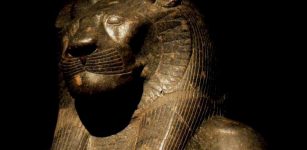 66 Diorite Statues Of Lion-Headed Goddess Sekhmet Discovered In Luxor, Egypt
Archaeology | Mar 9, 2017
66 Diorite Statues Of Lion-Headed Goddess Sekhmet Discovered In Luxor, Egypt
Archaeology | Mar 9, 2017 -
 Full-Sized Model Of Noah’s Ark Created In The U.S. To Show People The Evolution Theory Is False
News | Oct 20, 2022
Full-Sized Model Of Noah’s Ark Created In The U.S. To Show People The Evolution Theory Is False
News | Oct 20, 2022 -
 Moll Cutpurse – London’s Queen Of Thieves
Featured Stories | Jan 15, 2019
Moll Cutpurse – London’s Queen Of Thieves
Featured Stories | Jan 15, 2019 -
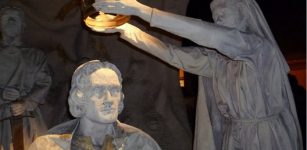 On This Day In History: Robert I, King Of Scots Known As ‘Robert The Bruce’ Was Born – On July 11, 1274
News | Jul 11, 2016
On This Day In History: Robert I, King Of Scots Known As ‘Robert The Bruce’ Was Born – On July 11, 1274
News | Jul 11, 2016 -
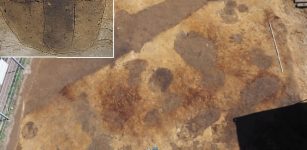 Roman Naval Base of Haltern in Germany Was Rebuilt Four Times 2,000 Years Ago
Archaeology | May 8, 2023
Roman Naval Base of Haltern in Germany Was Rebuilt Four Times 2,000 Years Ago
Archaeology | May 8, 2023 -
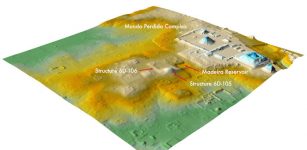 Hidden Ancient Citadel In The Mayan City Of Tikal Discovered By LIDAR
Archaeology | Sep 28, 2021
Hidden Ancient Citadel In The Mayan City Of Tikal Discovered By LIDAR
Archaeology | Sep 28, 2021 -
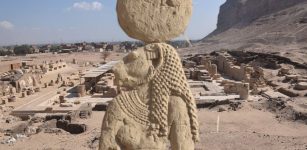 Is An Ancient Temple Dedicated To The Lioness Goddess Repit Hidden In The Cliffs Of Athribis?
Archaeology | Dec 10, 2024
Is An Ancient Temple Dedicated To The Lioness Goddess Repit Hidden In The Cliffs Of Athribis?
Archaeology | Dec 10, 2024 -
 On This Day In History: Johannes Kepler ‘Father Of Modern Astronomy’ Was Born – On Dec 27, 1571
News | Dec 27, 2016
On This Day In History: Johannes Kepler ‘Father Of Modern Astronomy’ Was Born – On Dec 27, 1571
News | Dec 27, 2016 -
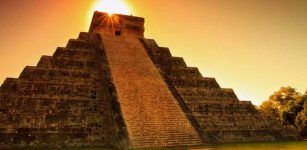 Impressive Pyramid Of Kukulkan (El Castillo’) At Chichen Itza
Civilizations | Feb 7, 2017
Impressive Pyramid Of Kukulkan (El Castillo’) At Chichen Itza
Civilizations | Feb 7, 2017 -
 Carved Symbols Related To The Galician Castro Culture Discovered At Castro de San Vicenzo, Orense, Spain
Archaeology | Oct 11, 2024
Carved Symbols Related To The Galician Castro Culture Discovered At Castro de San Vicenzo, Orense, Spain
Archaeology | Oct 11, 2024 -
 Researchers Confirm Museum Shrunken Head As Human Remains
Archaeology | Aug 4, 2022
Researchers Confirm Museum Shrunken Head As Human Remains
Archaeology | Aug 4, 2022 -
 Discovery Sheds Light On Why Pacific Islands Were Colonized
Archaeology | Apr 22, 2022
Discovery Sheds Light On Why Pacific Islands Were Colonized
Archaeology | Apr 22, 2022 -
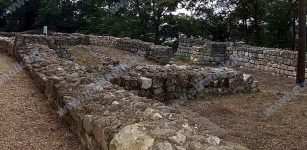 Fortress Wall Of Ancient Roman City Of Sexaginta Prista Discovered
Archaeology | Apr 16, 2016
Fortress Wall Of Ancient Roman City Of Sexaginta Prista Discovered
Archaeology | Apr 16, 2016 -
 Charles VI Of France – The King Who Was Made Of Glass
Featured Stories | Jan 22, 2016
Charles VI Of France – The King Who Was Made Of Glass
Featured Stories | Jan 22, 2016 -
 New Clues May Explain Collapse Of Ancient City Teotihuacan In Mexico
Archaeology | Sep 22, 2022
New Clues May Explain Collapse Of Ancient City Teotihuacan In Mexico
Archaeology | Sep 22, 2022 -
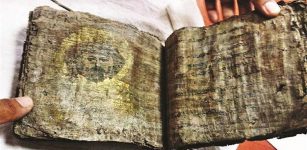 A Millennium-Old Gilded Bible Seized In Tokat, Turkey
Archaeology | Oct 28, 2015
A Millennium-Old Gilded Bible Seized In Tokat, Turkey
Archaeology | Oct 28, 2015 -
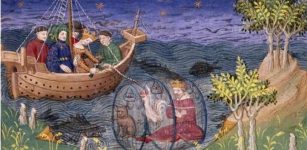 Science Fiction Was Around In Medieval Times – Here’s What It Looked Like
Featured Stories | Sep 18, 2018
Science Fiction Was Around In Medieval Times – Here’s What It Looked Like
Featured Stories | Sep 18, 2018 -
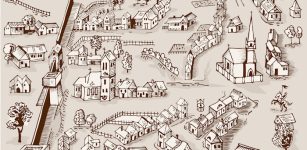 Wolstenholme Towne: Lost Virginia Settlement – Destroyed, Abandoned And Forgotten
Featured Stories | Jun 26, 2018
Wolstenholme Towne: Lost Virginia Settlement – Destroyed, Abandoned And Forgotten
Featured Stories | Jun 26, 2018 -
 Dropa Stones: Did A 12,000 Year-Old Extraterrestrial Spaceship Crash On Earth?
Ancient Mysteries | Oct 2, 2015
Dropa Stones: Did A 12,000 Year-Old Extraterrestrial Spaceship Crash On Earth?
Ancient Mysteries | Oct 2, 2015 -
 Sacred Cherokee Star Mound And The Legend Of The Star People – Beneath The Ground May Lie A Secret That Should Remain Hidden Forever
Featured Stories | Mar 23, 2025
Sacred Cherokee Star Mound And The Legend Of The Star People – Beneath The Ground May Lie A Secret That Should Remain Hidden Forever
Featured Stories | Mar 23, 2025

